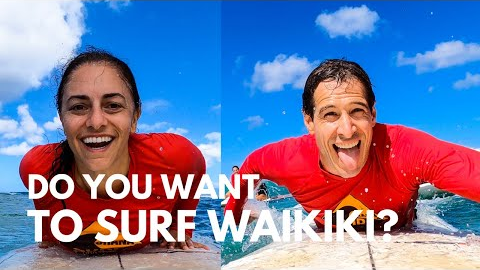Waikiki Surf Lessons for Your Hawaii Vacation | Want to Surf Waikiki Beach?
35,781 View
Share this Video
- Publish Date:
- June 30, 2025
- Category:
- Surfing
- Video License
- Standard License
- Imported From:
- Youtube
Tags

A Hawaii vacation isn’t complete without trying to surf and there is not better place to surf than Waikiki Beach. We had a blast polishing our skills with Waikiki surf lessons by Ohana Surf Project.
Erica is a better pupil than me. She was a natural while I needed a lot more coaching. Regardless of your skill level, from beginner to pro, Ohana Surf Project will get you on your feet and surfing the famous Waikiki break.
Learn more about surf lessons with Ohana Surf Project here:
https://thehawaiivacationguide.com/surfing-waikiki-with-ohana-surf-project/
This is a partnership link, thanks for watching and we know you will have the same great time with your surf lesson!
Check out our $27 Oahu itinerary that includes our Step-by-Step Video on How to Complete Hawaii Pre-Travel Testing Program.
https://thehawaiivacationguide.com/Oahu/
Our bi-weekly email newsletter for traveling to Hawaii in 2021:
https://thehawaiivacationguide.com/openupdates/
Waikiki Surf Lessons: What to Expect
00:00 Intro
01:06 Part 1: Surf School Safety and Etiquette
01:24 Part 2: Surf training on the beach
02:15 Part 3: Surfing Waikiki Beach (Publics)
03:17 Our favorite part of Waikiki surf lessons
Mahalo for watching our Hawaii family #travelvlog.
Click Subscribe for more of our adventures and tips on traveling to Hawaii (plus subscribing helps us out!).
#oahu #hawaii #waikiki
Disclaimer. Your use of the information provided in our Content, Itineraries, Site and Services is for your informational purposes only and is subject to our Privacy Policy and Terms of Service. Your use of the information described in, your participation in activities presented in, and/or your engagement of any Travel Service Providers presented in our Content, Itineraries, Site and/or Services may carry the risk of illness, bodily injury, disability, death, or property damage. You voluntarily and freely assume all risks and dangers that may occur pursuant to your access, use, purchase or participation in any information, activity, good or service described in our Content, Itineraries, Site and Services or provided by any Travel Service Providers.
Terms of Service: https://thehawaiivacationguide.com/terms-conditions/
Privacy Policy: https://thehawaiivacationguide.com/privacy-policy/
Credits:
Google Earth https://www.google.com/earth/
——————————————————
Music is from the fabulous Epidemic Sound. Sign up here for licensed music for YouTube, Instagram, or any content creation your heart creates:
https://thehawaiivacationguide.com/epidemic-sound
——————————————————
Follow us on Instagram for behind the scenes content: @thehawaiivacationguide https://www.instagram.com/thehawaiivacationguide/
——————————————————
Sign up for our Hawaii Opens Update email here - https://thehawaiivacationguide.com/openupdates/
Here’s Erica’s FREE One Week Maui Itinerary with Kids - https://thehawaiivacationguide.com/the-best-adults-only-resorts-in-hawaii/
We also love to share our FREE 5-Day Oahu Itinerary - https://thehawaiivacationguide.com/5-day-oahu-itinerary/
——————————————————
OUR CAMERA GEAR (keep it simple for your vacation!):
Underwater camera: GoPro HERO 8 https://amzn.to/3wJFuYK
Use your smartphone for video but keep it smooth with a gimbal: OSMO DJI https://amzn.to/2SOIHHJ
Don’t lose your GoPro, invest in a floaty
Floaty stick: https://amzn.to/3zIoggm
Floaty cover: https://amzn.to/3j7uTD5
Vlogging camera (but use your phone for a family holiday): https://amzn.to/3h1QxpF
——————————————————
POPULAR VIDEOS
The Best Hawaiian Island for First-Timers video - https://www.youtube.com/watch?v=niOXH...
Which Hawaiian Island Should You Visit - https://youtu.be/2mIYF41vnhw
The Best Time to Visit Hawaii - https://youtu.be/cNDHNoAacoc
-----------------------------------
Barrier Builders: Tidal Sediment and Erosion Sculpting Coastal Sandbar Formations and Shoals
Understanding Sandbar Formations
Sandbar formations are fascinating natural structures that play a crucial role in shaping our coastal landscapes. These underwater ridges, composed primarily of sediment, are formed by the continuous action of tides and currents. As tidal waters move in and out, they transport and deposit sediment, gradually building up these barriers and shoals that define the coastal regions.
The Role of Tidal Forces
Tidal forces are the primary drivers behind the formation of sandbars. The ebb and flow of tides create dynamic water movements that redistribute sediment along the coastline. During high tide, water levels rise, allowing sediment to spread out, while low tide exposes these sediments, leading to their accumulation in specific areas. This cyclic process is essential in shaping the barriers and shoals that protect inland areas from the direct impact of ocean waves.
Sediment Distribution and Coastal Protection
Sediment plays a pivotal role in the development of sandbar formations. The size, type, and availability of sediment materials determine the stability and growth of these structures. Fine sands tend to form extensive, gentle sandbars, while coarser materials can lead to the creation of more resilient and pronounced barriers. These sandbars act as natural buffers, absorbing wave energy and reducing coastal erosion, thereby safeguarding coastal ecosystems and human settlements.
Erosion and its Impact on Sandbar Stability
Erosion is a natural process that influences the longevity and shape of sandbar formations. Strong wave action and storm events can erode these barriers, altering their structure and position. However, erosion also contributes to the continuous reshaping and dynamic nature of coastal environments. Understanding the balance between sediment deposition and erosion is key to managing and conserving these valuable coastal features.
Barriers and Shoals: Distinguishing Features
While often used interchangeably, barriers and shoals have distinct characteristics. Barriers are elongated landforms that run parallel to the coastline, providing significant protection from oceanic forces. Shoals, on the other hand, are elevated areas of shallow water that can extend offshore, posing navigation challenges but also contributing to coastal protection. Both barriers and shoals are integral components of the complex interplay between tidal movements, sediment supply, and coastal dynamics.
The Future of Sandbar Formations
As coastal areas face increasing pressures from human activities and climate change, understanding the formation and maintenance of sandbars becomes more critical. Sustainable coastal management practices are essential to preserve these natural barriers, ensuring they continue to provide protection and maintain the ecological balance. Future research and innovative conservation strategies will play a vital role in safeguarding sandbar formations for generations to come.












